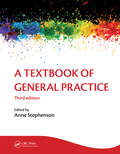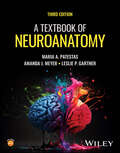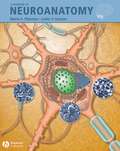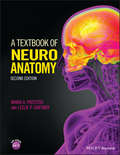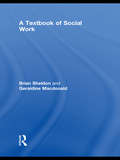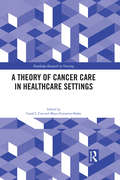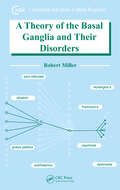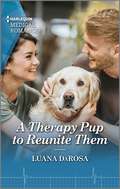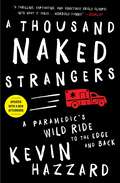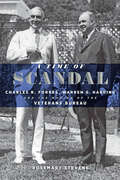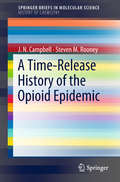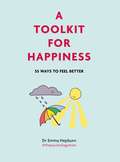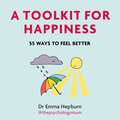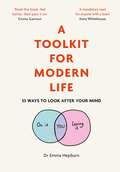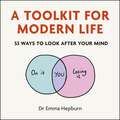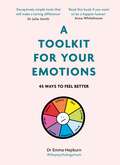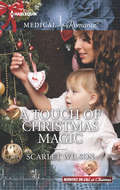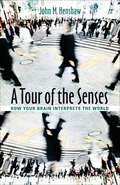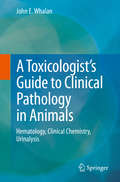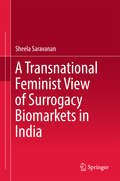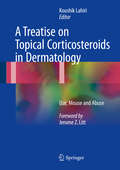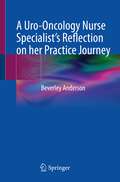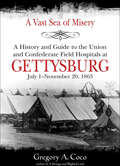- Table View
- List View
A Textbook of General Practice 3E
by Patrick White Ann WylieAn essential guide to general practice and being a general practitioner, A Textbook of General Practice is written specifically with the medical student and foundation doctor in mind. Reflecting current practice, the book does not seek to reiterate the content of a general medical textbook, but instead teaches the fundamental principles of general
A Textbook of Neuroanatomy
by Leslie P. Gartner Maria A. Patestas Amanda J. MeyerEasily master the anatomy and basic physiology of the nervous system in this concise, student-friendly update of this distinguished textbook A Textbook of Neuroanatomy has long served as the essential student introduction to the anatomy and systems of the brain. Covering brain organization, neural connections, and neural pathways in an accessible style, it contains the fundamental neurophysiology of every major brain area. Now fully updated to reflect the latest research and clinical data, it’s an essential resource for students in the life sciences with an interest in neuroscience. Readers of the third edition of A Textbook of Neuroanatomy will also find: New photomicrographic presentations of key anatomical structures New clinically-relevant topics in each chapter, including board-style questions Supplemental website incorporating figures, quizzes, bioinformatics worksheets, case studies, and more A Textbook of Neuroanatomy is ideal for advanced undergraduate and graduate students in neuroscience, neurology, and general clinical behavioral neuroscience and neuroanatomy.
A Textbook of Neuroanatomy
by Leslie P. Gartner Maria PatestasThis complete, yet concise text is designed to help students easily master the anatomy and basic physiology of the nervous system.<P><P> Accessible and clear, the text highlights interrelationships between systems, structures and the rest of the body as it moves through various regions of the brain. The first nine chapters introduce the main principles and terms in neuroanatomy, and the remaining chapters then use this information to describe the anatomy and function of the various pathways and discrete systems.Navigates students through the general principles and integrative components of the Nervous SystemHighlights interrelationships between systems, structures, and the rest of the bodyEmphasizes clinical relevance through clinical cases, questions, and follow-up discussions in each chapterIndicates medical conditions relevant to each chapter in the Clinical ConsiderationsFeatures an accompanying website, www.blackwellpublishing.com/patestas, which includes all the illustrations, along with animations of key processes; also available on CD-ROM. Please contact our Higher Education team at HigherEducation@wiley.com for more information.
A Textbook of Neuroanatomy
by Leslie P. Gartner Maria A. PatestasNewly revised and updated, A Textbook of Neuroanatomy, Second Edition is a concise text designed to help students easily master the anatomy and basic physiology of the nervous system. Accessible and clear, the book highlights interrelationships between systems, structures, and the rest of the body as the chapters move through the various regions of the brain. Building on the solid foundation of the first edition, A Textbook of Neuroanatomy now includes two new chapters on the brainstem and reflexes, as well as dozens of new micrographs illustrating key structures. Throughout the book the clinical relevance of the material is emphasized through clinical cases, questions, and follow-up discussions in each chapter, motivating students to learn the information. A companion website is also available, featuring study aids and artwork from the book as PowerPoint slides. A Textbook of Neuroanatomy, Second Edition is an invaluable resource for students of general, clinical and behavioral neuroscience and neuroanatomy.
A Textbook of Social Work
by Geraldine Macdonald Brian SheldonWhere did professional social work originate from? How effective are social work interpretations in the lives of vulnerable people? A Textbook of Social Work provides a comprehensive discussion of social work practice and its evidence-base. It strikes a balance between the need for social workers to understand the social, economic, cultural, psychological and interpersonal factors which give rise to clients’ problems, and the need for them to know how best to respond with practical measures. Divided into three parts: the text covers the history and of social work as a movement and profession in the first, and social work methods and approaches in the second. The final part looks at the major specialisms, including, among others, chapters on: Children and families Youth Offenders and substance misusers Social work and mental health Disabled people Older People Providing a comprehensive guide to conceptual and methodological issues in social work and containing plentiful case studies and examples, this book is an essential read for social work students, as well as a valuable resource for practitioners and academics.
A Theory of Cancer Care in Healthcare Settings (Routledge Research in Nursing and Midwifery)
by Carol Cox Maya Zumstein-ShahaThis book provides healthcare professionals with a practice theory for the care and management of patients who have been diagnosed with cancer. It explores what patients experience and how healthcare professionals can assist them in dealing with their uncertainty and fear as well as planning for the future. Unique to the book is its explication of the emerging theory, ‘The Omnipresence of Cancer’, which is set in the context of a discussion of earlier theories also concerned with cancer care. Chapters demonstrate how ‘The Omnipresence of Cancer’ has been developed, validated through research and being further tested in relation to cancer care. In particular, a chapter on philosophical reflections using theory to produce knowledge for practice is included. Each chapter provides essential background, a synthesis of the current state of knowledge, and practice examples associated with cancer care. The combination of theoretical reflection and practice examples is designed to promote comprehension and guidance on implementation of the theory, as well as recommendations for practice. This book will be of significant interest to healthcare students and professionals working in the field of cancer care and oncology, particularly healthcare professionals working in advanced practice roles and nurse educators. It is also anticipated that professionals working in pastoral care, occupational therapy, social work and radiography will be interested in this book.
A Theory of the Basal Ganglia and Their Disorders (Conceptual Advances in Brain Research)
by Robert MillerThe Basal ganglia, to adopt a phrase of Churchill's, are "a riddle wrapped in a mystery, inside an enigma." And although there is a wealth of information available on them, this research field remains controversial due in part to the diverse number of disciplines involved. A Theory of the Basal Ganglia and Their Disorders provides a clear, coherent
A Therapy Pup to Reunite Them
by Luana DaRosaHow can a therapy dog handler focus on her work when she&’s unexpectedly reunited with her first love? Find out in Luana DaRosa&’s latest Harlequin Medical Romance…Reunited with her first love! Setting up a charity matching therapy dogs with patients in need is Dr. Raquel&’s calling. Her career took a back seat for too long and she can&’t afford to be distracted. Enter hotshot neurosurgeon Christian—her brother&’s best friend and her teenage crush!—who&’s looking for a pup for his niece. The tension between them is as unchanged as it is undeniable… Will one night to get things out of their systems solve all their problems?From Harlequin Medical: Life and love in the world of modern medicine.
A Thousand Naked Strangers: A Paramedic's Wild Ride to the Edge and Back
by Kevin HazzardA former paramedic&’s "thrilling, captivating" (Booklist), and mordantly funny account of a decade spent as a first responder in Atlanta saving lives and connecting with the drama and occasional beauty that lies inside catastrophe.In the aftermath of 9/11 Kevin Hazzard felt that something was missing from his life—his days were too safe, too routine. A failed salesman turned local reporter, he wanted to test himself, see how he might respond to pressure and danger. He signed up for emergency medical training and became, at age twenty-six, a newly minted EMT running calls in the worst sections of Atlanta. His life entered a different realm—one of blood, violence, and amazing grace. Thoroughly intimidated at first and frequently terrified, he experienced on a nightly basis the adrenaline rush of walking into chaos. But in his downtime, Kevin reflected on how people’s facades drop away when catastrophe strikes. As his hours on the job piled up, he realized he was beginning to see into the truth of things. There is no pretense five beats into a chest compression, or in an alley next to a crack den, or on a dimly lit highway where cars have collided. Eventually, what had at first seemed impossible happened: Kevin acquired mastery. And in the process he was able to discern the professional differences between his freewheeling peers, what marked each—as he termed them—as “a tourist,” “true believer,” or “killer.” Combining indelible scenes that remind us of life’s fragile beauty with laugh-out-loud moments that keep us smiling through the worst, A Thousand Naked Strangers is an absorbing read about one man’s journey of self-discovery—a trip that also teaches us about ourselves.
A Time of Scandal: Charles R. Forbes, Warren G. Harding, and the Making of the Veterans Bureau
by Rosemary StevensWas the founding director of the US Veterans Bureau a criminal—or a scapegoat?In the early 1920s, with the nation still recovering from World War I, President Warren G. Harding founded a huge new organization to treat disabled veterans: the US Veterans Bureau, now known as the Department of Veterans Affairs. He appointed his friend, decorated veteran Colonel Charles R. Forbes, as founding director. Forbes lasted in the position for only eighteen months before stepping down under a cloud of criticism and suspicion. In 1926—after being convicted of conspiracy to defraud the federal government by rigging government contracts—he was sent to Leavenworth Penitentiary. Although he was known in his day as a drunken womanizer, and as a corrupt, betraying toady of a weak, blind-sided president, the question persists: was Forbes a criminal or a scapegoat? Historian Rosemary Stevens tells Forbes’s story anew, drawing on previously untapped records to reveal his role in America’s initial and ongoing commitment to veterans. She explores how Forbes’s rise and fall in Washington illuminates President Harding’s efforts to bring business efficiency to government. She also examines the Veterans Bureau scandal in the context of class, professionalism, ethics, and etiquette in a rapidly changing world. Most significantly, Stevens proposes a fascinating revisionist view of both Forbes and Harding—and raises questions about not only the validity but the source of their respective reputations. They did not defraud the government of billions of dollars, Stevens convincingly documents, and do not deserve the reputation they have carried for a hundred years.Packed with vibrant characters—conniving friends, FBI agents, and rival politicians split by sectional and ideological interests as well as gamblers, revelers, and wronged wives—A Time of Scandal will appeal to anyone interested in political gossip, presidential politics, the "Ohio Gang," and the 1920s.
A Time-Release History of the Opioid Epidemic (SpringerBriefs in Molecular Science)
by Steven M. Rooney J. N. CampbellThis Brief takes the reader on a chemical journey by following the history for over two centuries of how an opiate became an opioid, thus spawning an empire and a series of crises. These imperfect resemblances of alkaloids are both natural and synthetic substances that, particularly in America, are continually part of a growing concern about overuse. This seemed an inviting prospect for those in pain, but as the ubiquitous media coverage continues to lay bare, the levels of abuse point to the fact that perhaps an epidemic is upon us, if not a culture war. Seeking answers to how and why this addiction crisis transpired over two hundred years of long development, this Brief examines the role that the chemistry laboratory played in turning patients into consumers. By utilizing a host of diverse sources, this Brief seeks to trace the design and the production of opioids and their antecedents over the past two centuries. From the isolation and development of the first alkaloids with morphine that relieved pain within the home and on the battlefield, to the widespread use of nostrums and the addiction crisis that ensued, to the dissemination of drugs by what became known as Big Pharma after the World Wars; and finally, to competition from home-made pharmaceuticals, the progenitor was always, in some form, a type of chemistry lab. At times, the laboratory pressed science to think deeply about society's maladies, such as curing disease and alleviating pain, in order to look for new opportunities in the name of progress. Despite the best intentions opioids have created a paradox of pain as they were manipulated by creating relief with synthetic precision and influencing a dystopian vision. Thus, influence came in many forms, from governments, from the medical community, and from the entrepreneurial aspirations of the general populace. For better, but mostly for worse, all played a role in changing forever the trajectory of what started with the isolation of a compound in Germany. Combining chemistry and history in a rousing new long-form narrative that even broadens the definition of a laboratory, the origins and future of this complicated topic are carefully examined.
A Toolkit for Happiness: 55 Ways to Feel Better
by Dr Emma Hepburn'Mandatory for anyone with a brain' - Anna Whitehouse, founder of Mother Pukka'Relatable, practical and knowledgeable' - Gemma Bray, creator of The Organised Mum Method From clinical psychologist and author of A Toolkit for Modern Life, Dr Emma Hepburn, comes A Toolkit for Happiness - the ultimate guide to long-term and sustainable happiness.Using her much-loved trademark illustrations, Dr Hepburn arms us with 55 accessible and easy-to-use tools to boost our moods and feel better. She teaches us that happiness is as much about weathering the storms of life, accepting its natural ebbs and flows, as it is about enjoying the sunny weather - and that by implementing small and simple changes we can build a more compassionate brain that carries us through our daily lives, no matter the weather.From practical tools to aid you on those extra stormy days to thought-provoking exercises for your day-to-day mental wellbeing, A Toolkit for Happiness will you to cultivate positive habits, better understand your emotions and put you on the path to a healthier and happier you.
A Toolkit for Happiness: 55 Ways to Feel Better
by Dr Emma Hepburn'Mandatory for anyone with a brain' - Anna Whitehouse, founder of Mother Pukka'Relatable, practical and knowledgeable' - Gemma Bray, creator of The Organised Mum Method From clinical psychologist and author of A Toolkit for Modern Life, Dr Emma Hepburn, comes A Toolkit for Happiness - the ultimate guide to long-term and sustainable happiness.Using her much-loved trademark illustrations, Dr Hepburn arms us with 55 accessible and easy-to-use tools to boost our moods and feel better. She teaches us that happiness is as much about weathering the storms of life, accepting its natural ebbs and flows, as it is about enjoying the sunny weather - and that by implementing small and simple changes we can build a more compassionate brain that carries us through our daily lives, no matter the weather.From practical tools to aid you on those extra stormy days to thought-provoking exercises for your day-to-day mental wellbeing, A Toolkit for Happiness will you to cultivate positive habits, better understand your emotions and put you on the path to a healthier and happier you.
A Toolkit for Happiness: 55 Ways to Feel Better
by Emma Hepburn'Mandatory for anyone with a brain' - Anna Whitehouse, founder of Mother Pukka'Relatable, practical and knowledgeable' - Gemma Bray, creator of The Organised Mum Method From clinical psychologist and author of A Toolkit for Modern Life, Dr Emma Hepburn, comes A Toolkit for Happiness - the ultimate guide to long-term and sustainable happiness.Using her much-loved trademark illustrations, Dr Hepburn arms us with 55 accessible and easy-to-use tools to boost our moods and feel better. She teaches us that happiness is as much about weathering the storms of life, accepting its natural ebbs and flows, as it is about enjoying the sunny weather - and that by implementing small and simple changes we can build a more compassionate brain that carries us through our daily lives, no matter the weather.From practical tools to aid you on those extra stormy days to thought-provoking exercises for your day-to-day mental wellbeing, A Toolkit for Happiness will you to cultivate positive habits, better understand your emotions and put you on the path to a healthier and happier you.
A Toolkit for Modern Life: 53 Ways to Look After Your Mind
by Dr Emma Hepburn'Emma has a unique way of cutting through to the heart of the issues we all face day-in-day-out. There isn't another book out there like this and it should be a mandatory read for anyone with a brain.' - Anna Whitehouse, founder of Mother Pukka In this warm, wise book, clinical psychologist Dr Emma Hepburn (Instagram's @thepsychologymum) introduces her proven and practical tools for taking care of your mental and emotional wellbeing every day.Using her trademark illustrations, Dr Hepburn (aka @thepsychologymum) shines a welcome ray of light into the neglected corners of your brain. From identifying what triggers unhappy thoughts to overcoming the fear of making mistakes, A Toolkit for Modern Life will help you to cultivate positive habits and feel more confident, happier and in tune with yourself.* Call out and manage feelings of imposter syndrome* Answer back to your inner critic* Become aware of and monitor your emotional capacity* Spot unhelpful thoughts and develop more helpful patterns of thinking* Understand how the emotions cycle affects you* Identify what triggers anxiety for you and how to intercept it* Overcome the fear of making mistakes* Spot and call out your 'catastrophizing'* Identify and disarm social media comparisons* Align your decisions and actions with your core values* Assemble your own mental health toolkit for life
A Toolkit for Modern Life: 53 Ways to Look After Your Mind
by Dr Emma Hepburn'Emma has a unique way of cutting through to the heart of the issues we all face day-in-day-out. There isn't another book out there like this and it should be a mandatory read for anyone with a brain.' - Anna Whitehouse, founder of Mother PukkaIn this warm, wise audiobook, clinical psychologist Dr Emma Hepburn talks you through her proven and practical tools for taking care of your mental and emotional wellbeing every day.Let Dr Hepburn (Instagram's @thepsychologymum) shine a welcome ray of light into the neglected corners of your brain. From identifying what triggers unhappy thoughts to overcoming the fear of making mistakes, A Toolkit for Modern Life will help you to cultivate positive habits and feel more confident, happier and in tune with yourself.* Call out and manage feelings of imposter syndrome* Answer back to your inner critic* Become aware of and monitor your emotional capacity* Spot unhelpful thoughts and develop more helpful patterns of thinking* Understand how the emotions cycle affects you* Identify what triggers anxiety for you and how to intercept it* Overcome the fear of making mistakes* Spot and call out your 'catastrophizing'* Identify and disarm social media comparisons* Align your decisions and actions with your core values* Assemble your own mental health toolkit for life(P)2020 Quercus Editions Limited
A Toolkit for Modern Life: 53 Ways to Look After Your Mind
by Emma Hepburn'Emma has a unique way of cutting through to the heart of the issues we all face day-in-day-out. There isn't another book out there like this and it should be a mandatory read for anyone with a brain.' - Anna Whitehouse, founder of Mother Pukka In this warm, wise book, clinical psychologist Dr Emma Hepburn (Instagram's @thepsychologymum) introduces her proven and practical tools for taking care of your mental and emotional wellbeing every day.Using her trademark illustrations, Dr Hepburn (aka @thepsychologymum) shines a welcome ray of light into the neglected corners of your brain. From identifying what triggers unhappy thoughts to overcoming the fear of making mistakes, A Toolkit for Modern Life will help you to cultivate positive habits and feel more confident, happier and in tune with yourself.* Call out and manage feelings of imposter syndrome* Answer back to your inner critic* Become aware of and monitor your emotional capacity* Spot unhelpful thoughts and develop more helpful patterns of thinking* Understand how the emotions cycle affects you* Identify what triggers anxiety for you and how to intercept it* Overcome the fear of making mistakes* Spot and call out your 'catastrophizing'* Identify and disarm social media comparisons* Align your decisions and actions with your core values* Assemble your own mental health toolkit for life
A Toolkit for Your Emotions: 45 ways to feel better
by Dr Emma HepburnIn A Toolkit for Your Emotions, Emma takes a deep dive into how we feel and explains all the tools you need to intercept and redirect challenging emotion. From joy to anger, shame to stress and anxiety, Emma has practical and effective ways to feel instantly calmer and more content.Each topic is illustrated with Emma's well-loved illustration to make them accessible, meaningful and memorable. Dr Emma Hepburn is the most well-known psychologist on Instagram (@thepsychologymum, 135k followers) and has won numerous awards for her contribution to mental health awareness.
A Touch of Christmas Magic (Midwives On-Call at Christmas #1)
by Scarlet WilsonA family to heal him? After a rocky beginning, midwife Bonnie Reid is surprised when the head obstetrician Jacob Layton offers her and her little daughter, Freya, a place to stay. Bonnie's looking for a fresh start, but she didn't expect it to be with brooding-and totally gorgeous-Jacob... Family life has never been an option for Jacob-especially after his recent cancer diagnosis. Yet the Christmas magic Bonnie and Freya bring into his home makes Jacob feel more alive than ever! It's supposed to be temporary, but can Jacob really let Bonnie go?
A Tour of the Senses: How Your Brain Interprets the World
by John M. Henshaw2012 Outstanding Academic Title, Choice MagazineEver wonder why some people have difficulty recognizing faces or why food found delicious in one culture is reviled in another? John M. Henshaw ponders these and other surprising facts in this fascinating and fast-paced tour of the senses.From when stimuli first excite our senses to the near-miraculous sense organs themselves to the mystery of how our brain interprets senses, Henshaw explains the complex phenomena of how we see, feel, taste, touch, and smell. He takes us through the rich history of sensory perception, dating back to Aristotle’s classification of the five main senses, and helps us understand the science and technology behind sensory research today.A Tour of the Senses travels beyond our human senses. Henshaw describes artificial sensing technologies and instruments, unusual sensory abilities of the animal kingdom, and techniques for improving, rehabilitating, and even replacing sense organs. This entertaining introduction to sensory science is a clever mix of research findings and real-world stories that helps us understand the complex processes that turn sensory stimuli into sophisticated brain responses.
A Toxicologist's Guide to Clinical Pathology in Animals: Hematology, Clinical Chemistry, Urinalysis
by John E. WhalanThis guide provides an easy-to-use desk reference for diagnostic information on commonly used hematology, clinical chemistry and urinalysis parameters. Additional reference materials are provided as an aid in evaluating clinical pathology data. For many toxicologists, the evaluation of hematology, clinical chemistry and urinalysis data can be the most challenging aspect of animal toxicity studies. In a typical toxicity study, dozens of parameters are measured several times over the course of the study. There may be hundreds of data points, each of which needs to be considered. A Toxicologist's Guide to Clinical Pathology in Animals will serve as an essential primer for toxicologists in training and in industry as well as for researchers and professionals in a veterinary practice or a laboratory.
A Transnational Feminist View of Surrogacy Biomarkets in India
by Sheela SaravananThis book takes a reproductive justice approach to argue that surrogacy as practised in the contemporary neoliberal biomarkets crosses the humanitarian thresholds of feminism. Drawing on her ethnographic work with surrogate mothers, intended parents and medical practitioners in India, the author shows the dark connections between poverty, gender, human rights violations and indignity in the surrogacy market. In a developing country like India, bio-technologies therefore create reproductive objects of certain female bodies while promoting an image of reproductive liberation for others. India is a classic example for how far these biomarkets can exploit vulnerabilities for individual requirements in the garb of reproductive liberty. This critical book refers to a range of liberal, radical and postcolonial feminist frameworks on surrogacy, and questions the individual reproductive rights perspective as an approach to examine global surrogacy. It introduces ‘humanitarian feminism’ as an alternative concept to bridge feminist factions divided on contextual and ideological grounds. It hopes to build a global feminist solidarity drawing on a ‘reproductive justice’ approach by recognizing the histories of race, class, gender, sexuality, ability, age and immigration oppression in all communities. This work is of interest to researchers and students of medical sociology and anthropology, gender studies, bioethics, and development studies.
A Treatise on Topical Corticosteroids in Dermatology: Use, Misuse and Abuse
by Koushik LahiriThis treatise aims to fill up the lacuna and to contribute significantly to the dissemination of knowledge about the indication/contraindication, mechanism of action, ethical use, side-effects and various other facets related to topical corticosteroid. Topical corticosteroids (TC) have greatly enhanced dermatologists' ability to effectively treat several difficult dermatoses. The available range of formulations and potencies allows them to flexibly treat all groups of patients, different phases of disease, and different anatomic sites. Improper/incomplete knowledge about topical corticosteroids' mechanism of action, indications, classifications, and contraindications has produced a rapid rise in the incidence of improper use of these drugs, which could potentially bring disrepute to this entire group of amazing drugs. Responsibility for disseminating proper knowledge regarding when, where, and how to use TC both to internists and patients primarily rests with dermatologists. In this regard, the benefits of rational and ethical use and the potential harm of overuse and misuse for nonmedical, especially cosmetic purposes, should be clearly conveyed before prescribing TC.
A Uro-Oncology Nurse Specialist’s Reflection on her Practice Journey
by Beverley AndersonThis book provides a unique insight and background of a uro-oncology nurse’s career from a personal and professional perspective, one that encapsulates the ever changing dynamics in the nursing profession over 40 years - 1970’s to current, 2022. In writing this book, the objective is to devise a beneficial point of reference, one that is conducive to enlightening individuals within the healthcare profession and the wider context, on the art of reflection and acknowledging its benefits in terms of exploring their feelings and understanding their meaning. Reflection is a highly beneficial tool. In this context, the process enables the author to reflect constructively on her nursing career and practice, to highlight the positive as well as the negative aspects within that practice, and illustrate how the experiences gained have contributed to her development, personally and professionally, throughout that journey. Reflection includes deliberate reflection on experience, emotions, actions and responses and acknowledging how essential these have been to informing the author’s existing knowledge base and in ensuring a higher level of learning and understanding. In the continued quest to deliver optimal healthcare, the objective of reflection is in enabling healthcare individuals e.g. nursing students, newly qualified nurses or those considering change of nursing speciality, to better understand their patients from a holistic standpoint (physical, psychological, psycho-social, spiritual, cultural and economic) and ultimately, improving the individual patient’s overall experience – cancer or otherwise, as well as improving and enhancing practice outcomes. The importance of reflection and its contribution to increasing the healthcare professional’s self-awareness – emotional, personal and professional, is also well underlined. Various Modules and Case Studies within the book are used to explain and highlight key issues, and to enhance content and visual acuity.
A Vast Sea of Misery: A History and Guide to the Union and Confederate Field Hospitals at Gettysburg, July 1–November 20, 1863
by Gregory Coco“An extremely detailed history of 160 hospital sites that formed to care for soldiers who were wounded at the Battle of Gettysburg.” —Civil War CyclingNearly 26,000 men were wounded in the three-day battle of Gettysburg (July 1-3, 1863). It didn’t matter if the soldier wore blue or gray or was an officer or enlisted man, for bullets, shell fragments, bayonets, and swords made no class or sectional distinction. Almost 21,000 of the wounded were left behind by the two armies in and around the small town of 2,400 civilians. Most ended up being treated in makeshift medical facilities overwhelmed by the flood of injured. Many of these and their valiant efforts are covered in Greg Coco’s A Vast Sea of Misery.The battle to save the wounded was nearly as terrible as the battle that placed them in such a perilous position. Once the fighting ended, the maimed and suffering warriors could be found in churches, public buildings, private homes, farmhouses, barns, and outbuildings. Thousands more, unreachable or unable to be moved remained in the open, subject to the uncertain whims of the July elements. As one surgeon unhappily recalled, “No written nor expressed language could ever picture the field of Gettysburg! Blood! blood! And tattered flesh! Shattered bones and mangled forms almost without the semblance of human beings!”Based upon years of firsthand research, Coco’s A Vast Sea of Misery introduces readers to 160 of those frightful places called field hospitals. It is a sad journey you will never forget, and you won’t feel quite the same about Gettysburg once you finish reading.
